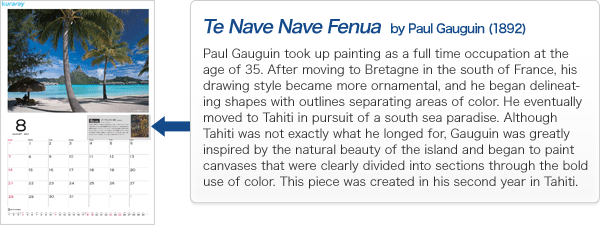News
Each year, Kuraray Co., Ltd. produces a highly popular, user-friendly calendar that takes "nature" as its theme.
For its 2011 edition, Kuraray has unveiled a calendar that focuses on famous paintings exhibited at the OHARA MUSEUM of ART (Kurashiki City, Okayama Prefecture), which was established by Kuraray founder Magosaburo Ohara, juxtaposed with photographs of the landscapes depicted therein. Featuring 12 representative landscape paintings selected from the museum collection, including "High Noon in the Alps" by Segantini, "Waterlilies" by Monet and "Te Nave Nave Fenua" by Gauguin, the central motif of the 2011 calendar is the beauty of the landscapes depicted in the paintings. Also included in the calendar are explanations of the eras in which the paintings were created and their histories as well as insight into the artists' thoughts and feelings toward their work.
The OHARA MUSEUM of ART was Japan's first private museum of Western art. Established in 1930 to honor Torajiro Kojima, an artist Magosaburo Ohara had long supported, the OHARA MUSEUM of ART recently commemorated its 80th anniversary.
1. Calendar Features
- (1) Each month features a photograph of a landscape that inspired a painting along with commentary supplied by the OHARA MUSEUM of ART. The last page of the calendar features thumbnail views of the photographs for each month.
- (2) This is a 14-page calendar comprising seven sheets of paper printed on both sides and is 52cm long x 36cm wide when fully opened. The calendar folds in half for delivery, making it compact, and double-sided printing was used to conserve paper resources.
- (3) The date boxes provide ample space for writing in appointments and notes and the numbers for the dates are shown clearly and in large type so that they can be seen easily from a distance.
- (4) The overall design is practical, functionally decorative and user-friendly.

2.The 2011 Kuraray Calendar "THE GREAT LANDSCAPES-Landscapes in Famous Paintings" Collection
| Name of Painting | Artist | Year Painted | |
|---|---|---|---|
| January | Cliffs of Greville | Jean-François Millet | 1871 |
| February | Landscape of Vetheuil | Bakusen Tsuchida | 1922 |
| March | Stream in Spring | Paul Sérusier | 1906-1917 |
| April | Landscape of La Ferté-Milon | Jean-Baptiste-Camille Corot | 1855-1865 |
| May | High Noon in the Alps | Giovanni Segantini | 1892 |
| June | Waterlilies | Claude Monet | circa 1906 |
| July | Summer in Asahi-gawa | Torajiro Kojima | 1913 |
| August | Te Nave Nave Fenua | Paul Gauguin | 1892 |
| September | Port of Marseilles | Albert Marquet | 1916 |
| October | Landscape | Paul Cezanne | 1885-1887 |
| November | Highly Cultivated Hills | Takeji Fujishima | 1938 |
| December | Small Table in Evening Dusk | Henri Le Sidaner | 1900-1918 |
